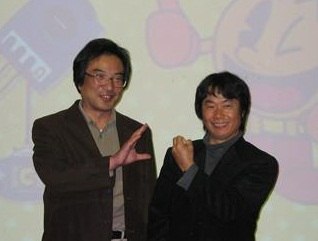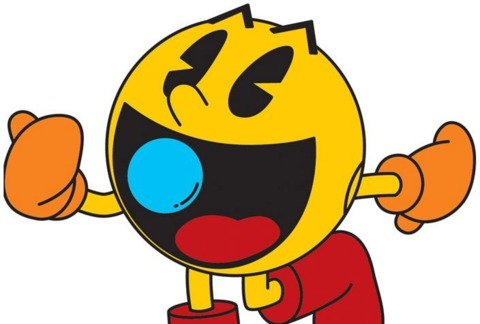Pac-Man man talks Pac-Man to pack of men
GDC 2011: Developer Toru Iwatani reveals how popular pellet-muncher came to be and why he has endured for so long.
Who was there: Toru Iwatani, designer of the original arcade version of Pac-Man.
What they talked about: In an hour-long session Wednesday afternoon, Iwatani discussed the mechanics of Pac-Man, as well as the factors that have contributed to the character's enduring popularity and relevance.

Iwatani began his presentation by showing how far Pac-Man's reach has extended beyond his humble arcade roots. The Pac-Man television series aired from 1982 to 1983 and appeared on 56 percent of television sets in the US. Pac-Man went on to spawn toys, books, and even telephones striking the familiar, open-mouthed pose Pac-Man is known for.
But none of those things would have existed if the original game hadn't connected with players. During development of Pac-Man, Iwatani followed a few guidelines he created, but one in particular rose above the rest, "Cool game players like to have challenges, but I feel fun should be the first point of any game." Achieving a fun experience is easier said than done, however, and Iwatani spent time to ensure Pac-Man would resonate long after release.
Before Iwatani decided on the core mechanics in Pac-Man, he wanted to make sure a few elements were implemented from the very beginning. First of all, the game had to be as simple as possible. Pac-Man is controlled using only a joystick, and that decision was very important, he said. Complex games can be intimidating, so stripping away extra inputs made it much easier for people to jump into the experience and immediately have fun.
Iwatani's second idea was that players should be able to understand the basics at a glance. In Pac-Man, he wanted to make sure players understood which character they controlled, which characters were the enemies, and the ultimate goal without any trouble. Following these two guidelines and ensuring the controls are smooth and responsive go a long way toward drawing prospective players in.
Iwatani also wanted to lure female gamers to his latest creation. In the early '80s, women didn't play games often, he explained. There weren't home consoles during this time, so players had to venture to arcades to experience the latest games. Arcades were populated mostly by boys and were therefore perceived as "dirty and smelly." He wanted to lure female gamers to arcades to make them "cleaner and brighter."
But the question remained: How does a game get the attention of women? Iwatani happened upon the idea that women love to eat, particularly desserts. Though he did chuckle when he delivered this quote, he wanted to build a game around consumption. Not only is eating the core gameplay mechanic Pac-Man is based on, but it's also where its name comes from. Puck-Man (the original name), means "munch" in Japanese, and that's the sound Pac-Man makes when he's chomping ghosts.

Once that idea started to simmer in Iwatani's head, he built more concrete concepts around those elements. In addition to making sure things remained simple to pick up and play, Iwatani wanted to use pretty colors to make the game as cute as possible. He also stressed that he wanted to do everything possible to make players feel cool. But most importantly, he wanted the ghosts to have their own characters.
First of all, it was important to have four different colors for the ghosts to contrast with the bright yellow Pac-Man and the blue edges of the maze. He chose red, light blue, pink, and orange as the colors to represent the ghosts. But he took the concept of individuality a step further by making sure each of the specters had its own personality.
The red ghost had the most basic artificial intelligence: chase Pac-Man. This was the relentless enemy who would constantly be right on Pac-Man's heels (figuratively speaking) to make sure players kept moving. The pink ghost was much more complicated. It attempted to position itself 32 pixels in front of Pac-Man's mouth. The blue ghost paid more attention to a mirror point on the map symmetrically opposite Pac-Man. And, finally, the movement of the orange ghost was completely random. Iwatani referred to the ghosts by their colors but didn't mention their names: Blinky, Inky, Pinky, and Clyde.
Iwatani made sure the ghosts all had unique movement patterns for a very specific reason. If they all directly followed Pac-Man, it wouldn't be a fun game because players would only have to be careful about what was behind them. He also added that the animation was important in developing personalities. Iwatani wanted to create a Tom and Jerry-like relationship between Pac-Man and his ghost enemies.
However, Iwatani's work wasn't done. He wanted to implement an offensive attack as well. He said the idea was that when players would eat a big cookie, they would flip the game on its head, changing roles from prey to predator. "It's a good feeling to be chasing, and not be chased."
The final step in the creation of Pac-Man was the difficulty. Games have to strike a balance in how challenging they are, Iwatani noted. If a game is too difficulty, it can turn off potential gamers. But if it's too easy, then it isn't stimulating. Iwatani wanted Pac-Man to increase in speed and difficulty whenever a maze was completed, but if players did end up dying, he wanted the game to go back to being easy. It was this progression that kept players of all skill levels invested, and he said it's one of the reasons Pac-Man is still being played today.
Quote: "I cooked this game with all the love I had for the player."--Iwatani on Pac-Man.
"Cool game players like to have challenges, but I feel fun should be the first point of any game."--Iwatani on his own design philosophy.
Takeaway: A developer needs a number of elements to make a game that has long-term impact. Huge target audience, accessibility, depth, and visual appeal are some of the main qualities Iwatani aimed for in designing the original Pac-Man.
Got a news tip or want to contact us directly? Email news@gamespot.com
Join the conversation